2.3E: Limit Laws and Techniques for Computing Limits EXERCISES
( \newcommand{\kernel}{\mathrm{null}\,}\)
2.3: The Limit Laws
In the following exercises, use the limit laws to evaluate each limit. Justify each step by indicating the appropriate limit law(s).
83)
- Answer:
-
Use constant multiple law and difference law:
l i m 𝑥 → 0 ( 4 𝑥 2 − 2 𝑥 + 3 ) = 4 l i m 𝑥 → 0 𝑥 2 − 2 l i m 𝑥 → 0 𝑥 + l i m 𝑥 → 0 3 = 3
84)
85)
- Answer:
-
Use root law:
l i m 𝑥 → − 2 √ 𝑥 2 − 6 𝑥 + 3 = √ l i m 𝑥 → − 2 ( 𝑥 2 − 6 𝑥 + 3 ) = √ 1 9
86)
In the following exercises, use direct substitution to evaluate each limit.
87)
- Answer:
- 49
88)
89)
- Answer:
- 1
90)
91)
- Answer:
− 5 7
92)
In the following exercises, use direct substitution to show that each limit leads to the indeterminate form
93)
- Answer:
l i m 𝑥 → 4 𝑥 2 − 1 6 𝑥 − 4 = 1 6 − 1 6 4 − 4 = 0 0 ; 𝑡 ℎ 𝑒 𝑛 , l i m 𝑥 → 4 𝑥 2 − 1 6 𝑥 − 4 = l i m 𝑥 → 4 ( 𝑥 + 4 ) ( 𝑥 − 4 ) 𝑥 − 4 = 8
94)
95)
- Answer:
l i m 𝑥 → 6 3 𝑥 − 1 8 2 𝑥 − 1 2 = 1 8 − 1 8 1 2 − 1 2 = 0 0
then,
96)
97)
- Answer:
l i m 𝑥 → 9 𝑡 − 9 √ 𝑡 − 3 = 9 − 9 3 − 3 = 0 0 ; 𝑡 ℎ 𝑒 𝑛 , l i m 𝑡 → 9 𝑡 − 9 √ 𝑡 − 3 = l i m 𝑡 → 9 𝑡 − 9 √ 𝑡 − 3 √ 𝑡 + 3 √ 𝑡 + 3 = l i m 𝑡 → 9 ( √ 𝑡 + 3 ) = 6
98)
99)
- Answer:
l i m 𝜃 → 𝜋 s i n 𝜃 t a n 𝜃 = s i n 𝜋 t a n 𝜋 = 0 0 ; 𝑡 ℎ 𝑒 𝑛 , l i m 𝜃 → 𝜋 s i n 𝜃 t a n 𝜃 = l i m 𝜃 → 𝜋 s i n 𝜃 s i n 𝜃 c o s 𝜃 = l i m 𝜃 → 𝜋 c o s 𝜃 = − 1
100)
101)
- Answer:
l i m 𝑥 → 1 / 2 2 𝑥 2 + 3 𝑥 − 2 2 𝑥 − 1 = 1 2 + 3 2 − 2 1 − 1 = 0 0 ; 𝑡 ℎ 𝑒 𝑛 , l i m 𝑥 → 1 / 2 2 𝑥 2 + 3 𝑥 − 2 2 𝑥 − 1 = l i m 𝑥 → 1 / 2 𝑓 𝑟 𝑎 𝑐 ( 2 𝑥 − 1 ) ( 𝑥 + 2 ) 2 𝑥 − 1 = 5 2
102)
In the following exercises, use direct substitution to obtain an undefined expression. Then, use the method of Example to simplify the function to help determine the limit.
103)
- Answer:
- −∞
104)
105)
- Answer:
- −∞
106)
In the following exercises, assume that
107)
- Answer:
l i m 𝑥 → 6 2 𝑓 ( 𝑥 ) 𝑔 ( 𝑥 ) = 2 l i m 𝑥 → 6 𝑓 ( 𝑥 ) l i m 𝑥 → 6 𝑔 ( 𝑥 ) = 7 2
108)
109)
- Answer:
l i m 𝑥 → 6 ( 𝑓 ( 𝑥 ) + 1 3 𝑔 ( 𝑥 ) ) = l i m 𝑥 → 6 𝑓 ( 𝑥 ) + 1 3 l i m 𝑥 → 6 𝑔 ( 𝑥 ) = 7
110)
111)
- Answer:
l i m 𝑥 → 6 √ 𝑔 ( 𝑥 ) − 𝑓 ( 𝑥 ) = √ l i m 𝑥 → 6 𝑔 ( 𝑥 ) − l i m 𝑥 → 6 𝑓 ( 𝑥 ) = √ 5
112)
113)
- Answer:
l i m 𝑥 → 6 [ ( 𝑥 + 1 ) 𝑓 ( 𝑥 ) ] = ( l i m 𝑥 → 6 ( 𝑥 + 1 ) ) ( l i m 𝑥 → 6 𝑓 ( 𝑥 ) ) = 2 8
114)
[T] In the following exercises, use the definition of the piecewise-defined function to evaluate the given limits (you may want to draw the graph).
115)
- a.
l i m 𝑥 → 3 − 𝑓 ( 𝑥 ) - b.
l i m 𝑥 → 3 + 𝑓 ( 𝑥 ) - c.
l i m 𝑥 → 3 𝑓 ( 𝑥 )
- Answer:
-
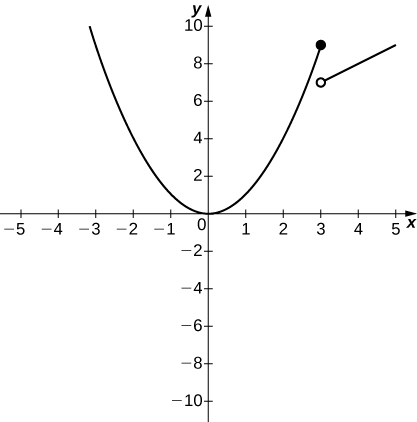
a. 9; b. 7; c. DNE
.
116)
- a.
l i m 𝑥 → 0 − 𝑔 ( 𝑥 ) - b.
l i m 𝑥 → 0 + 𝑔 ( 𝑥 ) - c.
l i m 𝑥 → 0 𝑔 ( 𝑥 )
117)
- a.
l i m 𝑥 → 2 − ℎ ( 𝑥 ) - b.
l i m 𝑥 → 2 + ℎ ( 𝑥 ) - c.
l i m 𝑥 → 2 ℎ ( 𝑥 )
- Answer:
- a. 1; b. 1; c. 1
In the following exercises, use the following graphs and the limit laws to evaluate each limit.
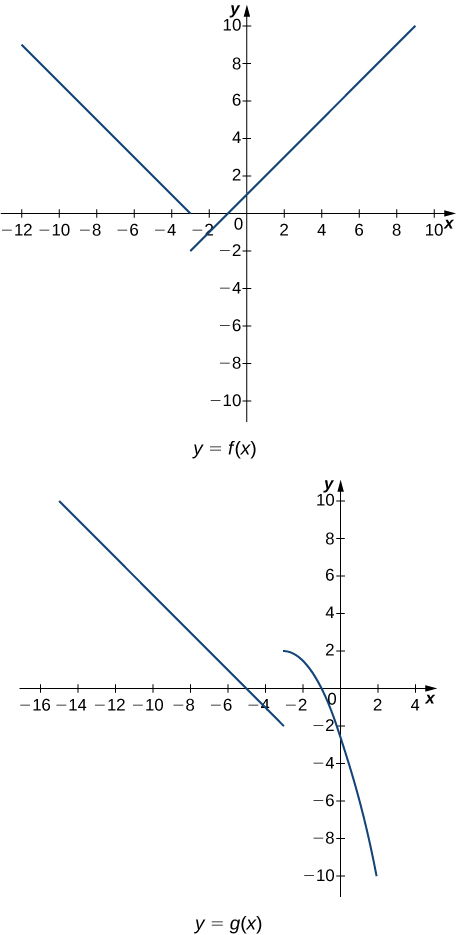
118)
119)
- Answer:
l i m 𝑥 → − 3 − ( 𝑓 ( 𝑥 ) − 3 𝑔 ( 𝑥 ) ) = l i m 𝑥 → − 3 − 𝑓 ( 𝑥 ) − 3 l i m 𝑥 → − 3 − 𝑔 ( 𝑥 ) = 0 + 6 = 6
120)
121)
- Answer:
l i m 𝑥 → − 5 2 + 𝑔 ( 𝑥 ) 𝑓 ( 𝑥 ) = 2 + ( l i m 𝑥 → − 5 𝑔 ( 𝑥 ) ) l i m 𝑥 → − 5 𝑓 ( 𝑥 ) = 2 + 0 2 = 1
122)
123)
- Answer:
l i m 𝑥 → 1 3 √ 𝑓 ( 𝑥 ) − 𝑔 ( 𝑥 ) = 3 √ l i m 𝑥 → 1 𝑓 ( 𝑥 ) − l i m 𝑥 → 1 𝑔 ( 𝑥 ) = 3 √ 2 + 5 = 3 √ 7
124)
125)
- Answer:
l i m 𝑥 → − 9 ( 𝑥 𝑓 ( 𝑥 ) + 2 𝑔 ( 𝑥 ) ) = ( l i m 𝑥 → − 9 𝑥 ) ( l i m 𝑥 → − 9 𝑓 ( 𝑥 ) ) + 2 l i m 𝑥 → − 9 ( 𝑔 ( 𝑥 ) ) = ( − 9 ) ( 6 ) + 2 ( 4 ) = − 4 6
For the following problems, evaluate the limit using the squeeze theorem. Use a calculator to graph the functions
126) [T] True or False? If
127) [T]
- Answer:
-
The limit is zero.
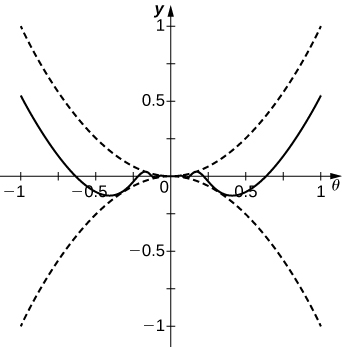
128)
129) [T] In physics, the magnitude of an electric field generated by a point charge at a distance r in vacuum is governed by Coulomb’s law:
a. Use a graphing calculator to graph
b. Evaluate
- Answer:
-
a
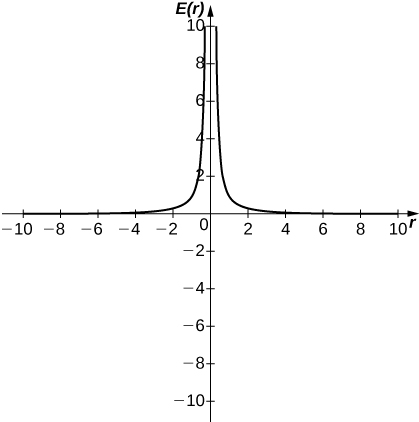
b. ∞. The magnitude of the electric field as you approach the particle q becomes infinite. It does not make physical sense to evaluate negative distance.
130) [T] The density of an object is given by its mass divided by its volume:
a. Use a calculator to plot the volume as a function of density
b. Evaluate
Chapter Review Exercises
212) Using the graph, find each limit or explain why the limit does not exist.
a.
b.
c.
d.
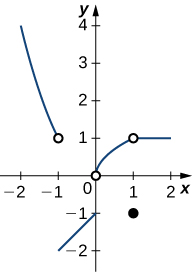
In the following exercises, evaluate the limit algebraically or explain why the limit does not exist.
213)
- Answer:
- 5
214)
215)
- Answer:
- 8/7
216)
217)
- Answer:
- DNE
218)
219)
- Answer:
- 2/3
220)
221) \displaystyle
- Answer:
- −4
222)
In the following exercises, use the squeeze theorem to prove the limit.
223)
- Answer:
- Since
− 1 ≤ 𝑐 𝑜 𝑠 ( 2 𝜋 𝑥 ) ≤ 1 − 𝑥 2 ≤ 𝑥 2 𝑐 𝑜 𝑠 ( 2 𝜋 𝑥 ) ≤ 𝑥 2 𝑙 𝑖 𝑚 𝑥 → 0 𝑥 2 = 0 = 𝑙 𝑖 𝑚 𝑥 → 0 − 𝑥 2 𝑙 𝑖 𝑚 𝑥 → 0 𝑥 2 𝑐 𝑜 𝑠 ( 2 𝜋 𝑥 ) = 0
224)

